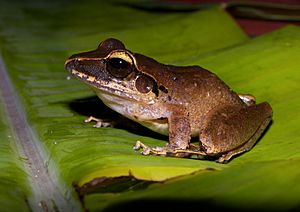Craugastor raniformis facts for kids
Quick facts for kids Craugastor raniformis |
|
|---|---|
 |
|
| Conservation status | |
| Scientific classification | |
| Synonyms | |
|
Hylodes raniformis Boulenger, 1896 |
The Craugastor raniformis is a type of frog often called the robber frog. It belongs to the Craugastoridae family of frogs. You can find this frog in Colombia and Panama.
This frog is quite common. It lives in wet lowland and mountain forests up to 1,500 meters (about 4,900 feet) above sea level. It also likes wet pastures. In Colombia's Pacific rainforests, it is one of the most common frogs in old farming areas. Because it can adapt to many places, this frog is not currently in danger of disappearing.
Meet the Robber Frog
The robber frog is a fairly large frog. It has a snout that looks a bit pointed. Female robber frogs are much bigger than males. Females can grow to be 52 to 74 millimeters (about 2 to 3 inches) long. Males are smaller, usually 27 to 43 millimeters (about 1 to 1.7 inches) long.
Robber Frog Life and Habits
During the day, these frogs hide on the forest floor. They often stay hidden under fallen leaves. At night, they become more active. They might climb up plants and trees, sometimes as high as 2.5 meters (about 8 feet) or more off the ground. Younger frogs and males tend to climb higher than the larger female frogs. When male robber frogs call out, it sounds like a "ha ha ha ha."
How Robber Frogs Have Babies
Female Craugastor raniformis frogs have been seen guarding their eggs. This is special because many frogs do not guard their eggs. Like other frogs in the Craugastor group, the robber frog lays its eggs on land, not in water. These eggs do not hatch into tadpoles. Instead, they hatch directly into tiny froglets that look like small versions of the adult frogs. Guarding the eggs probably helps protect them from animals that might eat them or from harmful fungi.
See also
 In Spanish: Craugastor raniformis para niños
In Spanish: Craugastor raniformis para niños


